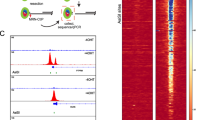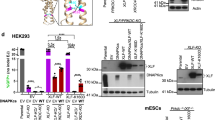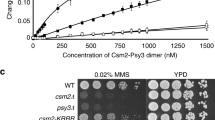Abstract
Double-strand breaks (DSBs) in DNA are caused by ionizing radiation. These chromosomal breaks can kill the cell unless repaired efficiently, and inefficient or inappropriate repair can lead to mutation, gene translocation and cancer1. Two proteins that participate in the repair of DSBs are Rad52 and Ku: in lower eukaryotes such as yeast, DSBs are repaired by Rad52-dependent homologous recombination, whereas vertebrates repair DSBs primarily by Ku-dependent non-homologous end-joining2. The contribution of homologous recombination to vertebrate DSB repair, however, is important3,4. Biochemical studies indicate that Ku binds to DNA ends and facilitates end-joining5. Here we show that human Rad52, like Ku, binds directly to DSBs, protects them from exonuclease attack and facilitates end-to-end interactions. Amodel for repair is proposed in which either Ku or Rad52 binds the DSB. Ku directs DSBs into the non-homologous end-joining repair pathway, whereas Rad52 initiates repair by homologous recombination. Ku and Rad52, therefore, direct entry into alternative pathways for the repair of DNA breaks.
This is a preview of subscription content, access via your institution
Access options
Subscribe to this journal
Receive 51 print issues and online access
$199.00 per year
only $3.90 per issue
Buy this article
- Purchase on Springer Link
- Instant access to full article PDF
Prices may be subject to local taxes which are calculated during checkout




Similar content being viewed by others
References
Friedberg, E. C., Walker, G. C. & Siede, W. DNA Repair and Mutagenesis (American Society for Microbiology, Washington, 1995).
Kanaar, R., Hoeijmakers, J. H. J. & van Gent, D. C. Molecular mechanisms of DNA double-strand break repair. Trends Cell Biol. 8, 483–489 (1998).
Liang, F., Han, M. G., Romanienko, P. J. & Jasin, M. Homology-directed repair is a major double-strand break repair pathway in mammalian cells. Proc. Natl Acad. Sci. USA 95, 5172–5177 (1998).
Takata, M. et al. Homologous recombination and non-homologous end-joining pathways of DNA double-strand break repair have overlapping roles in the maintenance of chromosomal integrity in vertebrate cells. EMBO J. 17, 5497–5508 (1998).
Critchlow, S. E. & Jackson, S. P. DNA end-joining: from yeast to man. Trends Biochem. Sci. 23, 394–398 (1998).
Sun, H., Treco, D. & Szostak, J. W. Extensive 3′-overhanging, single-stranded DNA associated with the meiosis-specific double-strand breaks at the ARG4 recombination initiation site. Cell 64, 1155–1162 (1991).
Sugawara, N. & Haber, J. E. Characterization of double-strand break-induced recombination: homology requirements and single-stranded DNA formation. Mol. Cell. Biol. 12, 563–575 (1992).
Shen, Z. et al. Self-association of human Rad52 protein. Mutat. Res. 364, 81–89 (1996).
Shinohara, A., Shinohara, M., Ohta, T., Matsuda, S. & Ogawa, T. Rad52 forms ring structures and cooperates with RPA in single-strand DNA annealing. Genes to Cells 3, 145–156 (1998).
Van Dyck, E., Hajibagheri, N. M. A., Stasiak, A. & West, S. C. Visualization of human Rad52 protein and its complexes with hRad51 and DNA. J. Mol. Biol. 284, 1027–1038 (1998).
Benson, F. E., Baumann, P. & West, S. C. Synergistic actions of Rad51 and Rad52 in genetic recombination and DNA repair. Nature 391, 401–404 (1998).
Baumann, P., Benson, F. E. & West, S. C. Human Rad51 protein promotes ATP-dependent homologous pairing and strand transfer reactions in vitro. Cell 87, 757–766 (1996).
Nussenzweig, A. et al. Requirement for Ku80 in growth and immunoglobulin V(D)J recombination. Nature 382, 551–555 (1996).
Nussenzweig, A., Sokol, K., Burgman, P., Li, L. G. & Li, G. C. Hypersensitivity of Ku80-deficient cell lines and mice to DNA damage: the effects of ionizing radiation on growth, survival, and development. Proc. Natl Acad. Sci. USA 94, 13588–13593 (1997).
Anderson, C. W. & Carter, T. H. in Molecular Analysis of DNA Rearrangements in the Immune System (eds Jessberger, R. & Lieber, M. R.) 91–112 (Springer, Heidelberg, 1996).
Rijkers, T. et al. Targeted inactivation of MmRAD52 reduces homologous recombination but not resistance to ionizing radiation. Mol. Cell. Biol. 18, 6423–6429 (1998).
Yamaguchi-Iwai, Y. et al. Homologous recombination, but not DNA repair, is reduced in vertebrate cells deficient in RAD52. Mol. Cell Biol. 18, 6430–6435 (1998).
Game, J. C. DNA double-strand breaks and the RAD50-RAD57 genes in Saccharomyces. Semin. Cancer Biol. 4, 73–83 (1993).
Petes, T. D., Malone, R. E. & Symington, L. S. in The Molecular and Cellular Biology of the Yeast Saccharomyces: Genome Dynamics, Protein Synthesis and Energetics 407–521 (Cold Spring Harbor Laboratory Press, New York, 1991).
Mortensen, U. H., Bendixen, C., Sunjevaric, I. & Rothstein, R. DNA strand annealing is promoted by the yeast Rad52 protein. Proc. Natl Acad. Sci. USA 93, 10729–10734 (1996).
Reddy, G., Golub, E. I. & Radding, C. M. Human Rad52 protein promotes single-strand DNA annealing followed by branch migration. Mutat. Res. 377, 53–59 (1997).
Sugiyama, T., New, J. H. & Kowalczykowski, S. C. DNA annealing by Rad52 protein is stimulated by specific interaction with the complex of replication protein A and single-stranded DNA. Proc. Natl Acad. Sci. USA 95, 6049–6054 (1998).
New, J. H., Sugiyama, T., Zaitseva, E. & Kowalczykowski, S. C. Rad52 protein stimulates DNA strand exchange by Rad51 and replication protein-A. Nature 391, 407–410 (1998).
Shinohara, A. & Ogawa, T. Stimulation by Rad52 of yeast Rad51-mediated recombination. Nature 391, 404–407 (1998).
Sung, P. Function of yeast Rad52 protein as a mediator between replication protein-A and the Rad51 recombinase. J. Biol. Chem. 272, 28194–28197 (1997).
Gasior, S. L., Wong, A. K., Kora, Y., Shinohara, A. & Bishop, D. K. Rad52 associates with RP-A and functions with Rad55 and Rad57 to assemble meiotic recombination complexes. Genes Dev. 12, 2208–2221 (1998).
Sung, P. Yeast Rad55 and Rad57 proteins form a heterodimer that functions with replication protein-A to promote DNA strand exchange by Rad51 recombinase. Genes Dev. 11, 1111–1121 (1997).
Subramani, S. & Seaton, B. L. in Genetic Recombination (eds Kucherlapati, R. & Smith, G. R.) 549–573 (American Society for Microbiology, Washington, DC, 1988).
Johnson, B. L., Thyagarajan, B., Krueger, L., Hirsch, B. & Campbell, C. Elevated levels of recombinational DNA repair in human somatic cells expressing the Saccharomyces cerevisiae RAD52 gene. Mutat. Res. DNA Repair 363, 179–189 (1996).
Park, M. S. Expression of human RAD52 confers resistance to ionizing radiation in mammalian cells. J. Biol. Chem. 270, 15467–15470 (1995).
Acknowledgements
We thank our colleagues for their interest, suggestions and careful reading of the manuscript. We also thank J. Dubochet for his interest in the project, and N. Hajibagheri for related electron microscopic analyses. This work was supported by the Imperial Cancer Research Fund, the Human Frontiers Science Program, the Swiss National Foundation and the Swiss-British Council Joint Research Program. E.V.D. was supported in part by an EC fellowship.
Author information
Authors and Affiliations
Corresponding author
Rights and permissions
About this article
Cite this article
Dyck, E., Stasiak, A., Stasiak, A. et al. Binding of double-strand breaks in DNA by human Rad52 protein. Nature 398, 728–731 (1999). https://doi.org/10.1038/19560
Received:
Accepted:
Issue Date:
DOI: https://doi.org/10.1038/19560
This article is cited by
-
Increasing the homologous recombination efficiency of eukaryotic microorganisms for enhanced genome engineering
Applied Microbiology and Biotechnology (2019)
-
Improvement in xylooligosaccharides production by knockout of the β-xyl1 gene in Trichoderma orientalis EU7-22
3 Biotech (2018)
-
Rad52 competes with Ku70/Ku86 for binding to S-region DSB ends to modulate antibody class-switch DNA recombination
Nature Communications (2017)
-
Light-inducible genetic engineering and control of non-homologous end-joining in industrial eukaryotic microorganisms: LML 3.0 and OFN 1.0
Scientific Reports (2016)
-
Gene targeting in the oil-producing fungus Mortierella alpina 1S-4 and construction of a strain producing a valuable polyunsaturated fatty acid
Current Genetics (2015)
Comments
By submitting a comment you agree to abide by our Terms and Community Guidelines. If you find something abusive or that does not comply with our terms or guidelines please flag it as inappropriate.



